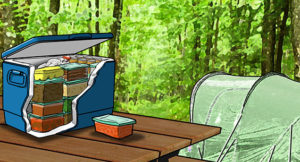
Camp food always tastes better than food at home. Something about the fresh air, surrounding wilderness and hungry wildlife nearby makes a good meal seem even more enjoyable.
Here are several techniques that can help with the creation of great camp meals to make the cooking process quicker and easier while in camp.
Start With a MealPplan
Taking a few minutes to plan several meals beforehand will save time in camp, and increase chances of a great camp-dining experience. The plan is a valuable tool to enable us to look ahead, and do as much of the heavy lifting as possible at home in a fully stocked kitchen.
Storage is Key
Start with a large supply of small to medium plastic storage containers. These are inexpensive and plentiful, and they really help organize the experience of cooking out of an insulated cooler.
Smaller is Better
When pre-prepping food for camp, fill up the containers being used, but use small containers. Handling, thawing, heating and serving is difficult with one large amount, and easy with several smaller ones. It is OK to have several small containers holding the same dish or ingredient.
Meats
Pre-cut meats served in bite sized pieces do not require a knife, fork and table to consume.
Most meat products can be precooked, frozen and reheated very well. Bacon and sausage are great precooked breakfast foods that can be reheated in a minute or two, cutting breakfast preparation time in half.
With steaks or chops, use smaller thinner cuts, and cook the meat to rare or medium rare. Then, when in camp, carefully reheat without overcooking in just a few minutes. Frozen precooked cuts will thaw slowly in the cooler until they are needed.
Vegetables
Chop, store and refrigerate potatoes and other large vegetables for cooking in camp. Smaller pieces cook through more quickly. Many can be precooked as well. If whole potatoes or large vegetables are preferred, boil or steam them at home, then cool, store and refrigerate. Reheat with steam in just about 8 to 10 minutes in camp.
Pre-mix salads, and store them in small containers without dressing. Croutons and other crunchy dry additions should be added with the dressing just before eating.
Casseroles and More
Mashed potatoes and gravy, spaghetti and sauce, lasagna, chili or stew, and most casserole dishes also do well prepared and frozen into smaller containers at home. Rice and sauce dishes also benefit from this method.
Lower Temp for Reheating
In camp, remember that a pre-prepped meal will require only a few minutes of cooking, at lower temperatures, to finish and be ready to serve. A covered skillet or pot with a couple of tablespoons of water will effectively reheat nearly any precooked dish. Allow frozen food to thaw before reheating, and watch the temperature and time to avoid overcooking.
Full Article : https://www.cabelas.com/category/Camp-Cabelas-Preparation-Techniques-That-Make-C/963652680.uts

